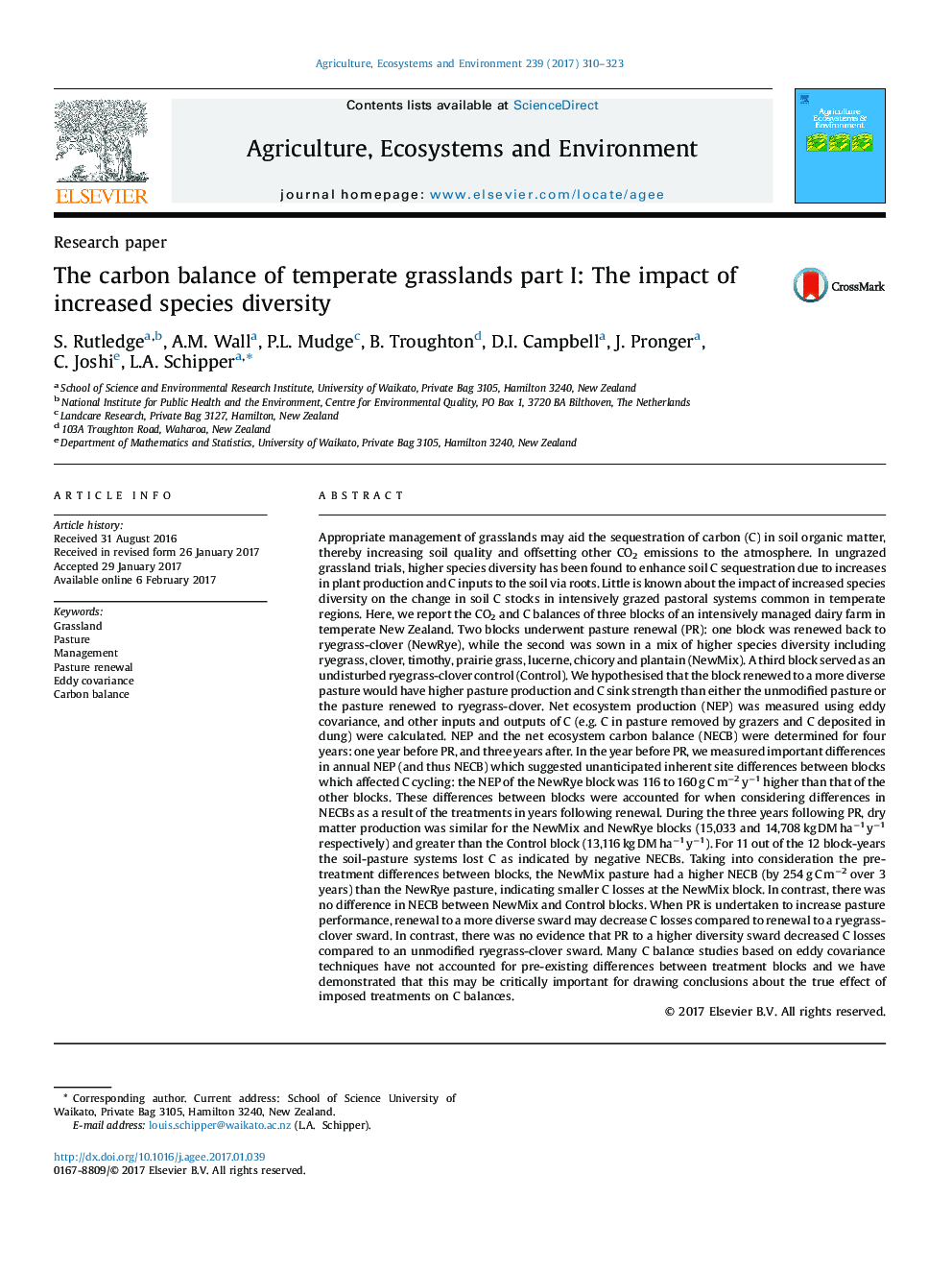| کد مقاله | کد نشریه | سال انتشار | مقاله انگلیسی | نسخه تمام متن |
|---|---|---|---|---|
| 5537938 | 1552013 | 2017 | 14 صفحه PDF | دانلود رایگان |
عنوان انگلیسی مقاله ISI
The carbon balance of temperate grasslands part I: The impact of increased species diversity
ترجمه فارسی عنوان
توازن کربن علفزارهای معتدل بخش 1: تأثیر تنوع گونه ای افزایش یافته
دانلود مقاله + سفارش ترجمه
دانلود مقاله ISI انگلیسی
رایگان برای ایرانیان
کلمات کلیدی
موضوعات مرتبط
علوم زیستی و بیوفناوری
علوم کشاورزی و بیولوژیک
علوم زراعت و اصلاح نباتات
چکیده انگلیسی
Appropriate management of grasslands may aid the sequestration of carbon (C) in soil organic matter, thereby increasing soil quality and offsetting other CO2 emissions to the atmosphere. In ungrazed grassland trials, higher species diversity has been found to enhance soil C sequestration due to increases in plant production and C inputs to the soil via roots. Little is known about the impact of increased species diversity on the change in soil C stocks in intensively grazed pastoral systems common in temperate regions. Here, we report the CO2 and C balances of three blocks of an intensively managed dairy farm in temperate New Zealand. Two blocks underwent pasture renewal (PR): one block was renewed back to ryegrass-clover (NewRye), while the second was sown in a mix of higher species diversity including ryegrass, clover, timothy, prairie grass, lucerne, chicory and plantain (NewMix). A third block served as an undisturbed ryegrass-clover control (Control). We hypothesised that the block renewed to a more diverse pasture would have higher pasture production and C sink strength than either the unmodified pasture or the pasture renewed to ryegrass-clover. Net ecosystem production (NEP) was measured using eddy covariance, and other inputs and outputs of C (e.g. C in pasture removed by grazers and C deposited in dung) were calculated. NEP and the net ecosystem carbon balance (NECB) were determined for four years: one year before PR, and three years after. In the year before PR, we measured important differences in annual NEP (and thus NECB) which suggested unanticipated inherent site differences between blocks which affected C cycling: the NEP of the NewRye block was 116 to 160 g C mâ2 yâ1 higher than that of the other blocks. These differences between blocks were accounted for when considering differences in NECBs as a result of the treatments in years following renewal. During the three years following PR, dry matter production was similar for the NewMix and NewRye blocks (15,033 and 14,708 kg DM haâ1 yâ1 respectively) and greater than the Control block (13,116 kg DM haâ1 yâ1). For 11 out of the 12 block-years the soil-pasture systems lost C as indicated by negative NECBs. Taking into consideration the pre-treatment differences between blocks, the NewMix pasture had a higher NECB (by 254 g C mâ2 over 3 years) than the NewRye pasture, indicating smaller C losses at the NewMix block. In contrast, there was no difference in NECB between NewMix and Control blocks. When PR is undertaken to increase pasture performance, renewal to a more diverse sward may decrease C losses compared to renewal to a ryegrass-clover sward. In contrast, there was no evidence that PR to a higher diversity sward decreased C losses compared to an unmodified ryegrass-clover sward. Many C balance studies based on eddy covariance techniques have not accounted for pre-existing differences between treatment blocks and we have demonstrated that this may be critically important for drawing conclusions about the true effect of imposed treatments on C balances.
ناشر
Database: Elsevier - ScienceDirect (ساینس دایرکت)
Journal: Agriculture, Ecosystems & Environment - Volume 239, 15 February 2017, Pages 310-323
Journal: Agriculture, Ecosystems & Environment - Volume 239, 15 February 2017, Pages 310-323
نویسندگان
S. Rutledge, A.M. Wall, P.L. Mudge, B. Troughton, D.I. Campbell, J. Pronger, C. Joshi, L.A. Schipper,
